Toyota Camry Intelligent Clearance Sonar (ICS) is an innovative safety feature that makes navigating tight parking spaces simple and safe at low speeds. If a collision with an object may occur due to the vehicle suddenly moving forward due to an accidental accelerator pedal operation, the vehicle moving the unintended direction due to the wrong shift position being selected, or while parking or traveling at low speeds, the sensors detect objects, such as a wall, in the traveling direction of the vehicle, and the system operates to lessen an impact with an object and reduce the resulting damage.

Examples of system operation
The system will operate in situations such as the following if an object is detected in the traveling direction of the vehicle.
When traveling at a low speed and the brake pedal is not depressed, or is depressed late
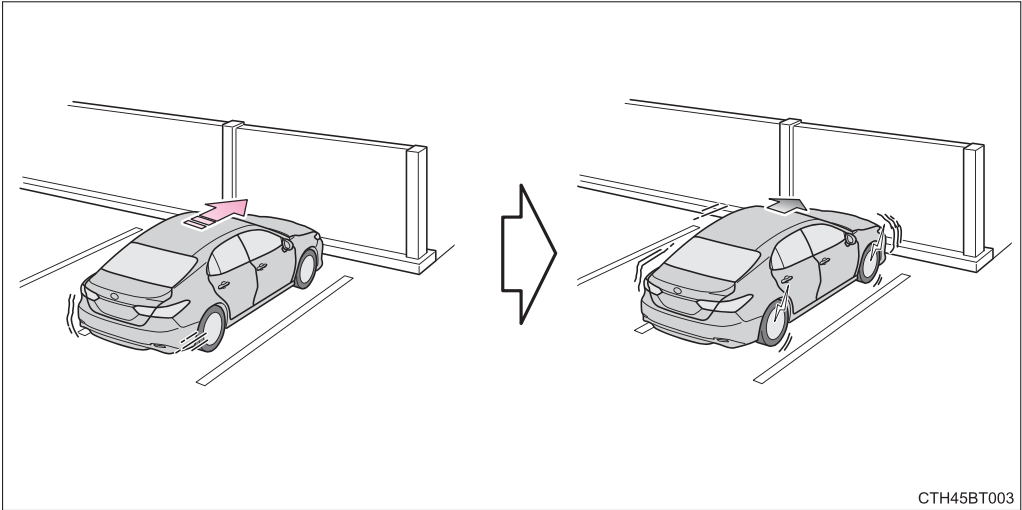
When the accelerator pedal is depressed excessively

When the vehicle moves in the unintended direction due to the wrong shift position being selected
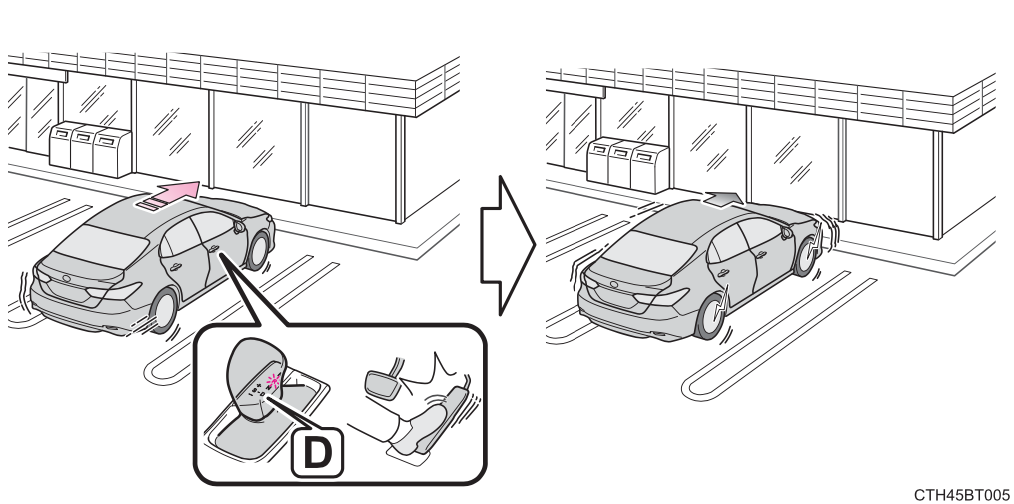
Rear Cross Traffic Auto Brake function
If a radar sensor detects a vehicle approaching from the right or left at the rear of the vehicle and a collision may occur, this function will perform brake control to reduce the likelihood of an impact with the approaching vehicle.
Examples of system operation
The system will operate in situations such as the following if an object is detected in the traveling direction of the vehicle.
When reversing, a vehicle is approaching and the brake pedal is not depressed, or is depressed late
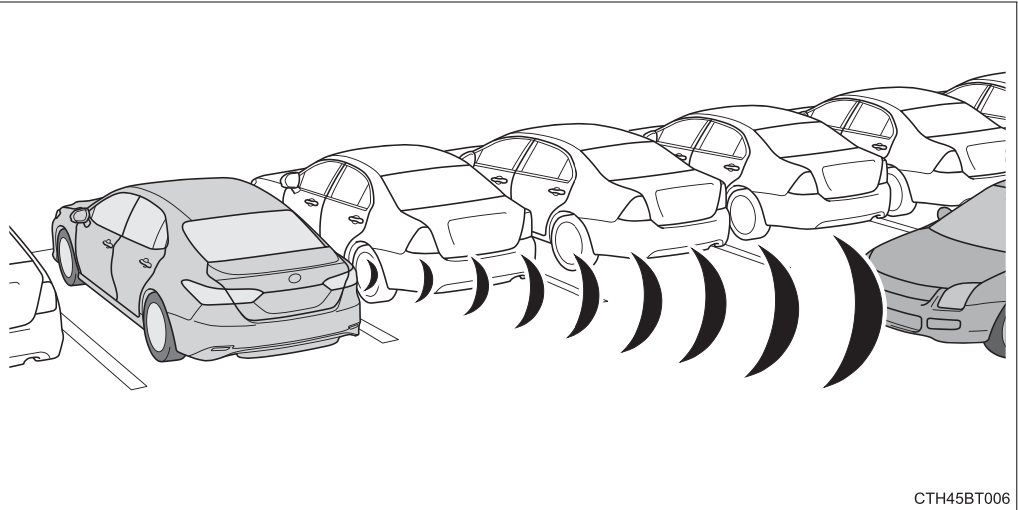
Types of sensors
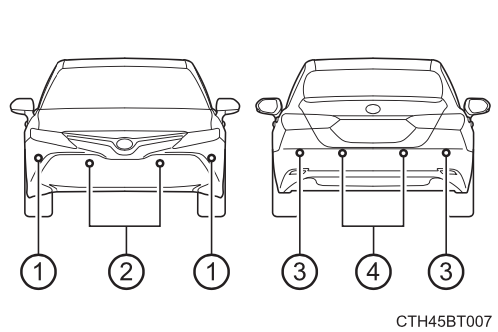
- Front corner sensors
- Front center sensors
- Rear corner sensors
- Rear center sensors
Turning the Intelligent Clearance Sonar system on/off
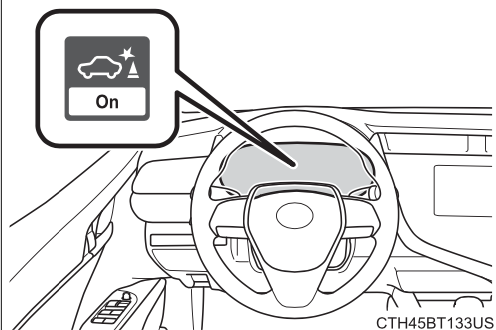
- Press / of the meter control switches, select .
- Press / of the meter control switches, select .
- Press OK of the meter control switch.
- Select the “Yes” and push OK.
When the Intelligent Clearance Sonar is disabled, the ICS OFF indicator illuminates.
To re-enable the system when it was disabled, select on the multi-information display, select and then “On”. If disabled using this method, the system will not be re-enabled by turning the engine switch off and then to IGNITION ON mode.
Displays and buzzers for engine output restriction control and brake control
If the engine output restriction control or brake control operates, a buzzer will sound and a message will be displayed on the multi-information display to alert the driver.
Depending on the situation, engine output restriction control will operate to either limit acceleration or restrict output as much as possible.
| Control | Situation | Multi-information display | ICS OFF Indicator | Buzzer |
|---|---|---|---|---|
| Engine output restriction control is operating (acceleration restriction) | Acceleration greater than a certain amount is not possible. | “Object Detected Acceleration Reduced” | Not illuminated | Short beep |
| Engine output restriction control is operating (output restricted as much as possible) | Stronger-thannormal brake operation is necessary. | “Brake!” | ||
| Brake control is operating | Emergency braking is necessary. | |||
| Vehicle stopped by system operation | The vehicle has been stopped by brake control operation. | “Switch to Brake” | Illuminated |
Intelligent Clearance Sonar function
If the Intelligent Clearance Sonar function detects that a collision with an object is possible, the engine output will be restricted to restrain any increase in the vehicle speed. (Engine output restriction control: See A below.)
Additionally, if the accelerator pedal continues to be depressed, the brakes will be applied automatically to reduce the vehicle speed. (Brake control: See B below.)
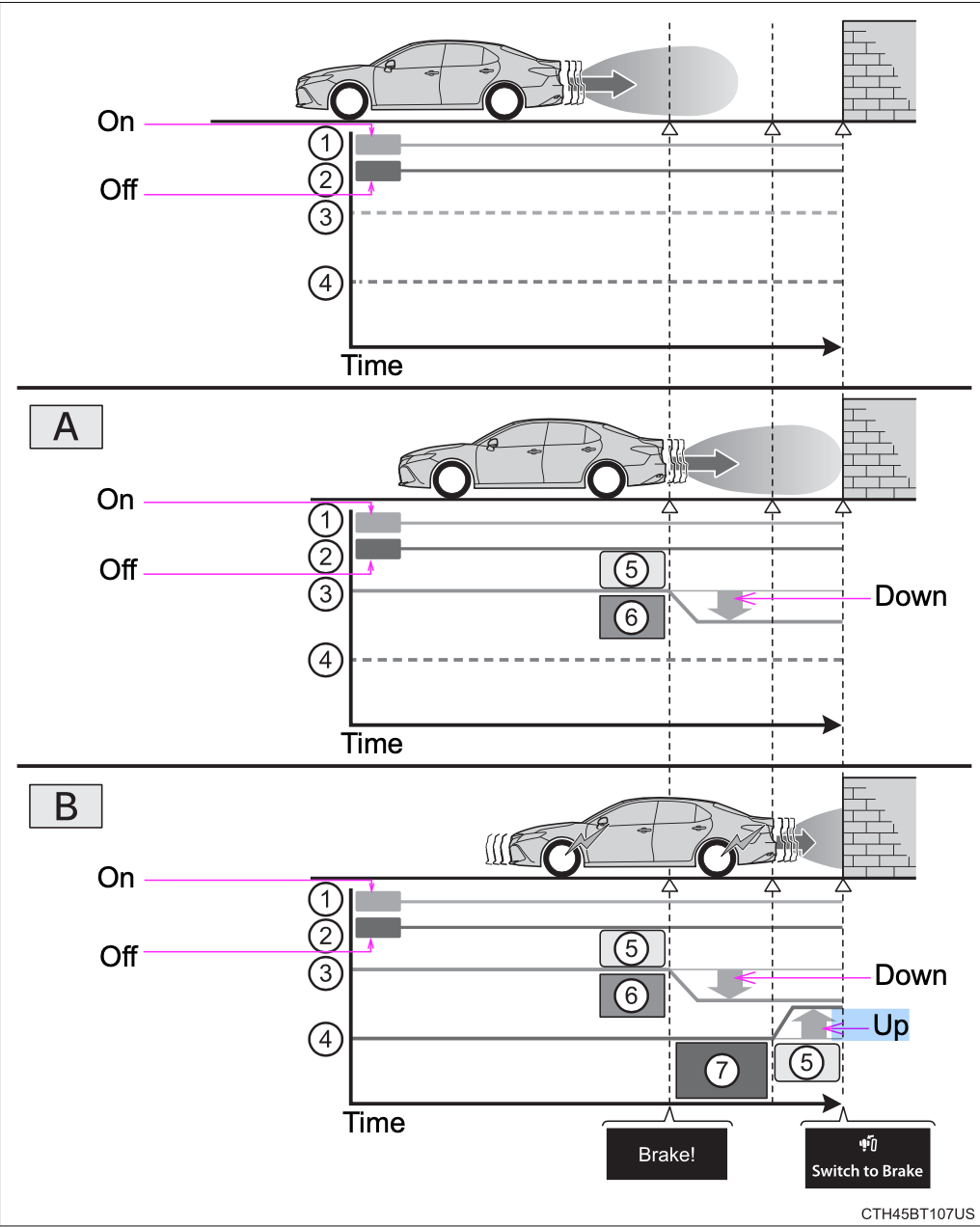
- Accelerator pedal
- Brake pedal
- Engine output
- Braking force
- Start of control
- High possibility of a collision
- Extremely high possibility of a collision
The Intelligent Clearance Sonar function will operate when
The function will operate when the ICS OFF indicator is not illuminated or flashing and all of the following conditions are met:
- Engine output restriction control
- The Intelligent Clearance Sonar system is enabled.
- The vehicle speed is 10 mph (15 km/h) or less.
- There is an object in the traveling direction of the vehicle and 6 to 13 ft. (2 to 4 m) away.
- The system determines that a stronger-than-normal brake operation is necessary to avoid a collision.
- Brake control
- Engine output restriction control is operating.
- The system determines that an emergency brake operation is necessary to avoid a collision.
The Intelligent Clearance Sonar function will stop operating when
The function will stop operating if any of the following conditions are met:
- Engine output restriction control
- The Intelligent Clearance Sonar system is disabled.
- The collision becomes avoidable with normal brake operation.
- The object is no longer 6 to 13 ft. (2 to 4 m) away in the traveling direction of the vehicle.
- Brake control
- The Intelligent Clearance Sonar system is disabled.
- Approximately 2 seconds elapse after the vehicle is stopped by brake control.
- The brake pedal is depressed after the vehicle is stopped by brake control.
- The object is no longer 6 to 13 ft. (2 to 4 m) away in the traveling direction of the vehicle.
Detection range of the Intelligent Clearance Sonar function
The detection range of the Intelligent Clearance Sonar function differs from the detection range of the intuitive parking assist.
Therefore, even if the intuitive parking assist detects an object and provides a warning, the Intelligent Clearance Sonar function may not start operating.
If the Intelligent Clearance Sonar function has operated
If the vehicle is stopped due to operation of the Intelligent Clearance Sonar function, the Intelligent Clearance Sonar system will be disabled and the ICS OFF indicator will illuminate.
Re-enabling the Intelligent Clearance Sonar system
To re-enable the Intelligent Clearance Sonar system when it is disabled due to operation of the Intelligent Clearance Sonar function, either enable the system again (P. 335), or turn the engine switch off and then back to IGNITION ON mode.
Additionally, if the object becomes no longer in the traveling direction of the vehicle or if the traveling direction of the vehicle changes (such as changing from moving forward to backing up, or from backing up to moving forward), the system will be re-enabled automatically.
Objects that the Intelligent Clearance Sonar function may not detect
The sensors may not be able to detect certain objects, such as the following.
- Cotton cloth, snow, and other materials that are poor reflectors of ultrasonic waves. (People may also not be detected depending on the type of clothing they are wearing.
- Objects which are not perpendicular to the ground, are not perpendicular to the traveling direction of the vehicle, are uneven or are waving.
- Low objects
- Thin objects such as wires, fences, ropes and signposts
- Objects that are extremely close to the bumper
Situations in which the Intelligent Clearance Sonar may not operate properly
When the shift lever is in N
Intuitive parking assist buzzer
Regardless of whether the intuitive parking assist system is enabled or not, if the Intelligent Clearance Sonar system is enabled , the front or rear sensors detect an object and brake control is performed, the intuitive parking assist buzzer will sound to notify the driver of the approximate distance to the object.
Situations in which the Intelligent Clearance Sonar function may operate even if there is no possibility of a collision
In some situations such as the following, the Intelligent Clearance Sonar function may operate even though there is no possibility of a collision.
- Vehicle surroundings
 When driving on a narrow road
When driving on a narrow road When driving on a gravel road or in an area with tall grass
When driving on a gravel road or in an area with tall grass- When driving toward a banner, flag, low-hanging branch or boom barrier (such as those used at railroad crossings, toll gates and parking lots).
- When driving on a narrow path surrounded by a structure, such as in a tunnel or on an iron bridge
- When parallel parking
- When there is a rut or hole in the surface of the road
- When driving on a metal cover (grating), such as those used for drainage ditches
- When driving on a steep slope
- If a sensor is hit by a large amount of water, such as when driving on a flooded road
- Weather
- If a sensor is covered with ice, snow, dirt, etc. (when cleared, the system will return to normal)
- If heavy rain or water strikes a sensor
- When driving in inclement weather such as fog, snow or a sandstorm
- Other ultrasonic waves sources
- When vehicle horns, vehicle detectors, motorcycle engines, air brakes of large vehicles, the clearance sonar of other vehicles or other devices which produce ultrasonic waves are near the vehicle
- If a sticker or an electronic component, such as a backlit license plate (especially fluorescent type), fog lights, a fender pole or wireless antenna is installed near a sensor
- Changes in the vehicle posture
- If the vehicle is significantly tilted
- If the front of the vehicle is raised or lowered due to the carried load
- If the orientation of a sensor has been changed due to a collision or other impact
If the Intelligent Clearance Sonar function operates unnecessarily such as at a railroad crossing
Even in the event that the Intelligent Clearance Sonar function operates unnecessarily, such as at a railroad crossing, brake control will be canceled after approximately 2 seconds, allowing you to proceed forward and leave the area, Brake control can also be canceled by depressing the brake pedal. Depressing the accelerator pedal again will allow you to proceed forward and leave the area.
Situations in which the Intelligent Clearance Sonar Brake function may not operate properly
In some situations such as the following, this function may not operate properly.
- Weather
 When a sensor or the area around a sensor is extremely hot or cold
When a sensor or the area around a sensor is extremely hot or cold When strong winds are blowing
When strong winds are blowing- If a sensor is covered with ice, snow, dirt, etc. (when cleared, the system will return to normal)
- If heavy rain or water strikes a sensor
- When driving in inclement weather such as fog, snow or a sandstorm
- Vehicle surroundings
- When an object that cannot be detected is between the vehicle and a detected object
- If an object such as a vehicle, motorcycle, bicycle or pedestrian cuts in front of the vehicle or runs out from the side of the vehicle.
- Other ultrasonic waves sources
- When vehicle horns, vehicle detectors, motorcycle engines, air brakes of large vehicles, the clearance sonar of other vehicles or other devices which produce ultrasonic waves are near the vehicle
- If a sticker or an electronic component, such as a backlit license plate (especially fluorescent type), fog lights, a fender pole or wireless antenna is installed near a sensor
- Changes in the vehicle posture
- If the vehicle is significantly tilted
- If the front of the vehicle is raised or lowered due to the carried load
- If the orientation of a sensor has been changed due to a collision or other impact
If a battery terminal has been disconnected and reconnected The system needs to be initialized.
To initialize the system, drive the vehicle straight ahead for 5 seconds or more at a speed of approximately 22 mph (35 km/h) or more.
If “ICS Unavailable” is displayed on the multi-information display and the ICS OFF indicator is flashing
Initialization may not have been performed after a battery terminal was disconnected and reconnected. Initialize the system.
If this message continues to be displayed even after initialization, have the vehicle inspected by your Toyota dealer.
If “ICS Unavailable” and “Parking Assist Unavailable Clean Parking Assist Sensor” are displayed on the multi-information display and the ICS OFF indicator is flashing
- A sensor may be covered with ice, snow, dirt, etc. In this case, remove the ice, snow, dirt, etc., from the sensor to return the system to normal. If this message is shown even after removing dirt from the sensor, or shown when the sensor was not dirty to begin with, have the vehicle inspected at your Toyota dealer.
- A sensor may be frozen. Once the ice melts, the system will return to normal.
- Water may be continuously flowing over the sensor surface, such as in a heavy rain. When the system determines that it is normal, the system will return to normal.
WARNING
Limitations of the Intelligent Clearance Sonar system
Do not overly rely on the system, as doing so may lead to an accident.
- The driver is solely responsible for safe driving. Always drive carefully, taking care to observe your surroundings. The Intelligent Clearance Sonar system is designed to provide support to lessen the severity of collisions. However, it may not operate in some situations.
- The Intelligent Clearance Sonar system is not designed to stop the vehicle completely. Additionally, even if the system has stopped the vehicle, it is necessary to depress the brake pedal immediately as brake control will be canceled after approximately 2 seconds.
To ensure the Intelligent Clearance Sonar system can operate properly
Observe the following precautions regarding the sensors. Failure to do so may cause a sensor to not operate properly, and may cause an accident.
- Do not modify, disassemble or paint the sensors.
- Do not replace a sensor with a part other than a genuine part.
- Do not subject a sensor or its surrounding area to a strong impact.
- Do not damage the sensors, and always keep them clean.
Observe the following precautions regarding the radar sensors. Failure to do so may cause a radar sensor to not operate properly, and may cause an accident. - Do not modify, disassemble or paint the sensors.
- Do not replace a radar sensor with a part other than a genuine part.
- Do not subject a radar sensor or its surrounding area to a strong impact.
- Do not damage the radar sensors, and always keep the radar sensors and their surrounding area on the bumper clean.
Handling the suspension
Do not modify the suspension, as changes to the height or inclination of the vehicle may prevent the sensors from detecting objects correctly or cause the system to not operate or operate unnecessarily.
To prevent the system from malfunctioning
- If the area around a sensor is subjected to an impact, the system may not operate properly due to the sensor being misaligned. Have the vehicle inspected by your Toyota dealer.
- When using a high pressure washer to wash the vehicle, do not spray the sensors directly, as doing so may cause a sensor to malfunction.
- When using steam to clean the vehicle, do not direct steam too close to the sensors as doing so may cause a sensor to malfunction.
To prevent a radar sensor from malfunctioning
- If the area around a radar sensor is subjected to an impact, the system may not operate properly due to a sensor malfunction. Have the vehicle inspected by your Toyota dealer.
- Observe the radar sensor handling precautions.
To prevent unnecessary operation of the Intelligent Clearance Sonar system
In the following situations, disable the Intelligent Clearance Sonar system as the system may operate even though there is no possibility of a collision.
- When inspecting the vehicle using a chassis roller, chassis dynamo or free roller
- When loading the vehicle onto a boat, truck or other transport vessel
- If the suspension has been modified or tires of a size other than specified are installed
- If the front of the vehicle is raised or lowered due to the carried load
- When equipment that may obstruct a sensor is installed, such as a towing eyelet, bumper protector (an additional trim strip, etc.), bicycle carrier, or snow plow
- When using an automatic car wash
Rear Cross Traffic Auto Brake function
If the Rear Cross Traffic Auto Brake function detects that a collision with an approaching vehicle is possible, the engine output will be restricted to restrain any increase in vehicle speed. (Engine output restriction control: See A below.)
Additionally, if the accelerator pedal continues to be depressed, the brakes will be applied automatically to reduce the vehicle speed. (Brake control: See B below.)
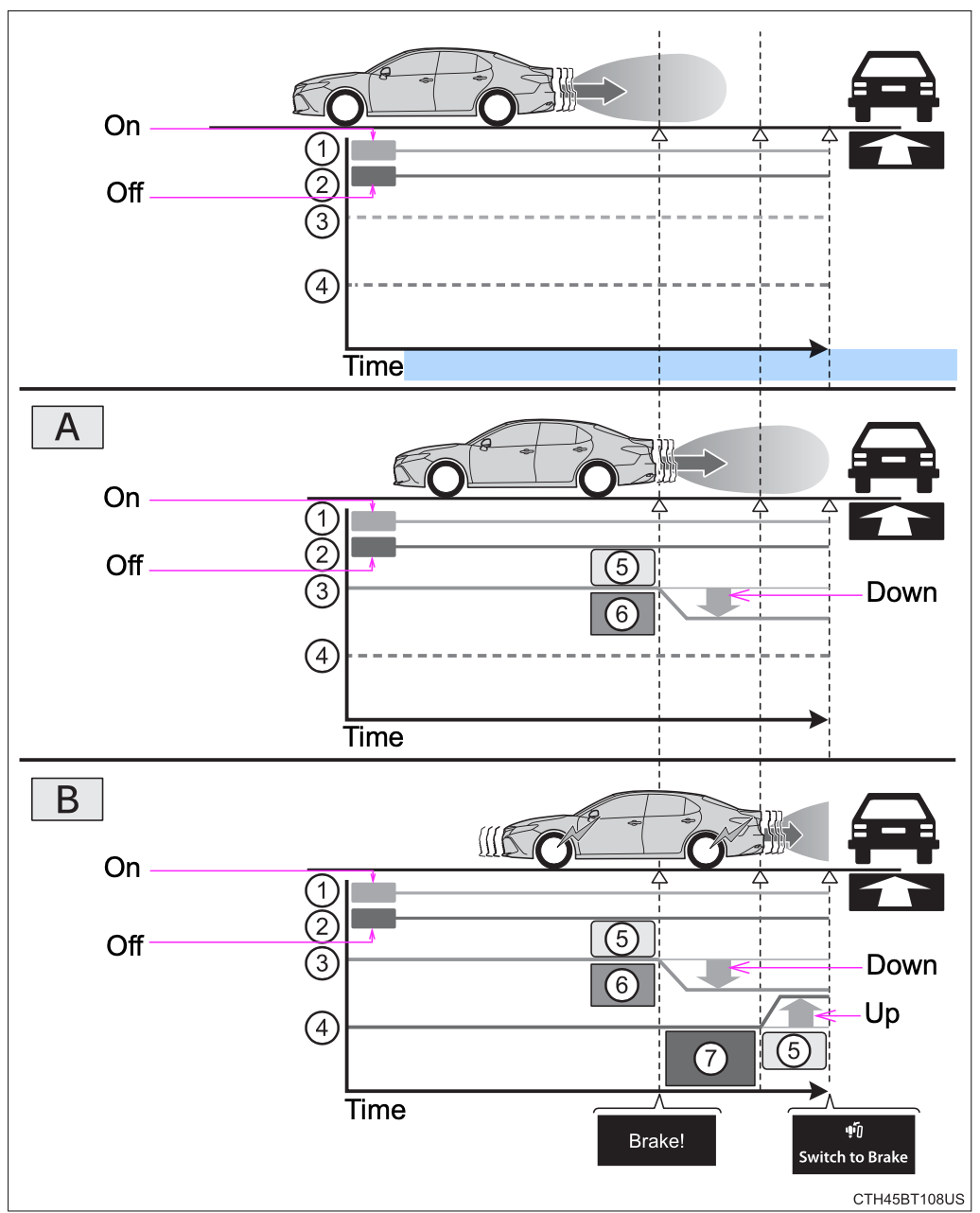
- Accelerator pedal
- Brake pedal
- Engine output
- Braking force
- Start of control
- High possibility of a collision
- Extremely high possibility of a collision
The Rear Cross Traffic Auto Brake function will operate when
The function will operate when the ICS OFF indicator is not illuminated or flashing and all of the following conditions are met:
- Engine output restriction control
- The Intelligent Clearance Sonar with Rear Cross Traffic Auto Brake is enabled.
- The vehicle speed is 10 mph (15 km/h) or less.
- The shift lever is in R.
- The system determines that a stronger than normal brake operation is necessary to avoid a collision with an approaching vehicle.
- Brake control
- Engine output restriction control is operating.
- The system determines that an emergency brake operation is necessary to avoid a collision with an approaching vehicle.
The Rear Cross Traffic Auto Brake function will stop operating when
The function will stop operating if any of the following conditions are met:
- Engine output restriction control
- The Intelligent Clearance Sonar with Rear Cross Traffic Auto Brake is disabled.
- The collision becomes avoidable with normal brake operation.
- A vehicle is no longer approaching from the right or left at the rear of the
vehicle.
- Brake control
- The Intelligent Clearance Sonar with Rear Cross Traffic Auto Brake is disabled.
- Approximately 2 seconds elapse after the vehicle is stopped by brake control.
- The brake pedal is depressed after the vehicle is stopped by brake control.
- A vehicle is no longer approaching from the right or left at the rear of the vehicle.
Detection area of the Rear Cross Traffic Auto Brake function
The detection area of the Rear Cross Traffic Auto Brake function differs from the detection area of the RCTA function.
Therefore, even if the RCTA function detects a vehicle and provides an alert, the Rear Cross Traffic Auto Brake function may not start operating.
If the Rear Cross Traffic Auto Brake function has operated
If the vehicle is stopped due to operation of the Rear Cross Traffic Auto Brake function, the Rear Cross Traffic Auto Brake function will be disabled and the ICS OFF indicator will illuminate.
Re-enabling the Rear Cross Traffic Auto Brake function
To re-enable the Rear Cross Traffic Auto Brake function when it is disabled while it is operating, either enable the Intelligent Clearance Sonar system again, or turn the engine switch off and then back to IGNITION ON mode. When the function is disabled, the ICS OFF indicator will illuminate.
If there is no longer a vehicle approaching from the right or left at the rear of the vehicle when backing up, or if the traveling direction of the vehicle changes (such as changing from backing up to moving forward), the system will be re-enabled automatically. When the function is re-enabled, the ICS OFF indicator will turn off.
Conditions under which the Rear Cross Traffic Auto Brake function will not detect a vehicle
The Rear Cross Traffic Auto Brake function is not designed to detect the following types of vehicles and/or objects:
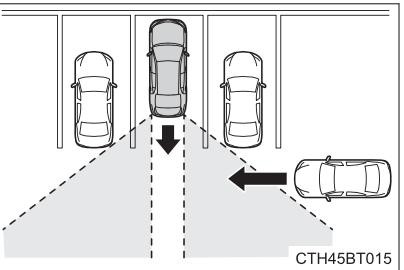
- Vehicles approaching from directly behind
- Vehicles backing up in a parking space next to your vehicle
- Vehicles that the sensors cannot detect due to obstructions
- Vehicles which suddenly accelerate or decelerate near your vehicle
- Guardrails, walls, signs, parked vehicles and similar stationary objects*
- Small motorcycles, bicycles, pedestrians, etc.*
- Vehicles moving away from your vehicle
- Vehicles approaching from the parking spaces next to your vehicle*
*: Depending on the conditions, detection of a vehicle and/or object may occur.
RCTA function buzzer
Regardless of whether the RCTA function is enabled or not (P. 311), if the Rear Cross Traffic Auto Brake function is enabled and brake control is performed, a buzzer will sound to notify the driver.
Situations in which the system may operate even though there is no possibility of a collision
In some situations such as the following, the Rear Cross Traffic Auto Brake function may operate even though there is no possibility of a collision.
 When the parking space faces a street and vehicles are being driven on the street
When the parking space faces a street and vehicles are being driven on the street When a detected vehicle turns while approaching the vehicle
When a detected vehicle turns while approaching the vehicle When a vehicle passes by the side of your vehicle
When a vehicle passes by the side of your vehicle When the distance between your vehicle and metal objects, such as a guardrail, wall, sign, or parked vehicle, which may reflect electrical waves toward the rear of the vehicle, is short
When the distance between your vehicle and metal objects, such as a guardrail, wall, sign, or parked vehicle, which may reflect electrical waves toward the rear of the vehicle, is short- When water is splashed or sprayed toward the rear bumper, such as from a sprinkler
Situations in which the Rear Cross Traffic Auto Brake function may not operate properly
In some situations such as the following, this function may not operate properly.
- Objects and vehicles which the radar sensors are not designed to detect
- Stationary objects
- Vehicles which are moving away from your vehicle
- Pedestrians, motorcycles, bicycles, etc.*
- Objects which are extremely close to a radar sensor
- Vehicles which are approaching from the right or left at the rear of the vehicle at a traveling speed of less than approximately 5 mph (8 km/h)
- Vehicles which are approaching from the right or left at the rear of the vehicle at a traveling speed of more than approximately 15 mph (24 km/h)
*: Depending on conditions, detection of a vehicle and/or object may occur.
- Situations in which the radar sensors may not be able to detect an object
- When a sensor or the area around a sensor is extremely hot or cold
- If the rear bumper is covered with ice, snow, dirt, etc.
- If heavy rain or water strikes the vehicle
- When the detection area of a radar sensor is obstructed by an adjacent vehicle
- If the vehicle is significantly tilted
- When equipment that may obstruct a sensor is installed, such as a towing eyelet, bumper protector (an additional trim strip, etc.), bicycle carrier, or snow plow
- If the suspension has been modified or tires of a size other than specified are installed
- If the front of the vehicle is raised or lowered due to the carried load
- If a sticker or an electronic component, such as a backlit license plate (especially fluorescent type), fog lights, a fender pole or wireless antenna is installed near a radar sensor
- If the orientation of a radar sensor has been changed due to a collision or other impact or removal and installation
- When multiple vehicles are approaching with only a small gap between each vehicle
- When a vehicle is approaching at high speed
- Situations in which the radar sensor may not detect a vehicle
- When a vehicle approaches from the right or left at the rear of the vehicle while you are turning while backing up
 When turning while backing up
When turning while backing up
When backing out of a shallow angle parking spot Vehicles that the sensors cannot detect due to obstructions
Vehicles that the sensors cannot detect due to obstructions When backing up on a slope with a sharp change in grade
When backing up on a slope with a sharp change in grade When a vehicle turns into the detection area
When a vehicle turns into the detection area
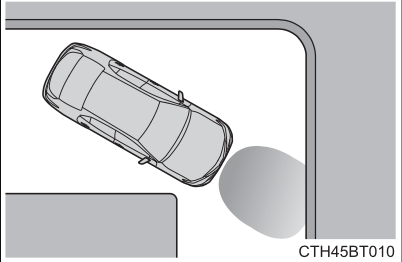 When driving on a narrow road
When driving on a narrow road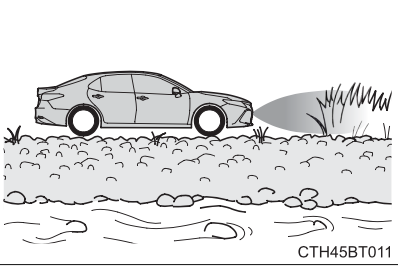 When driving on a gravel road or in an area with tall grass
When driving on a gravel road or in an area with tall grass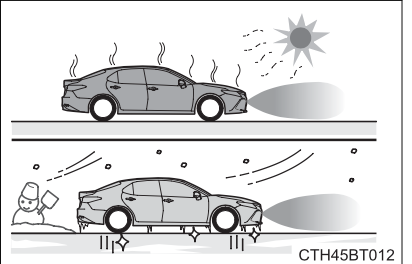 When a sensor or the area around a sensor is extremely hot or cold
When a sensor or the area around a sensor is extremely hot or cold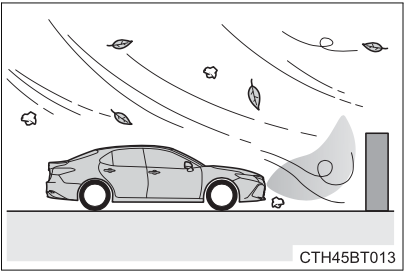 When strong winds are blowing
When strong winds are blowing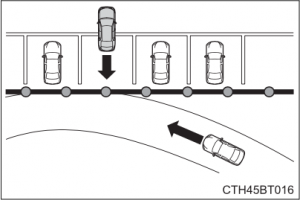 When the parking space faces a street and vehicles are being driven on the street
When the parking space faces a street and vehicles are being driven on the street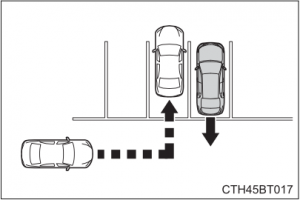 When a detected vehicle turns while approaching the vehicle
When a detected vehicle turns while approaching the vehicle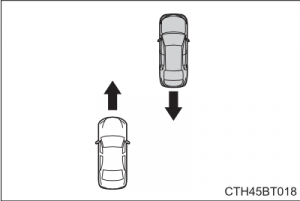 When a vehicle passes by the side of your vehicle
When a vehicle passes by the side of your vehicle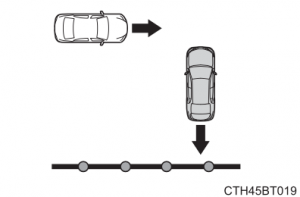 When the distance between your vehicle and metal objects, such as a guardrail, wall, sign, or parked vehicle, which may reflect electrical waves toward the rear of the vehicle, is short
When the distance between your vehicle and metal objects, such as a guardrail, wall, sign, or parked vehicle, which may reflect electrical waves toward the rear of the vehicle, is short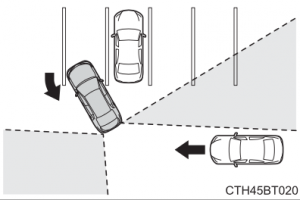 When turning while backing up
When turning while backing up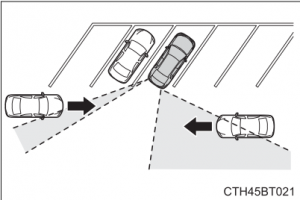
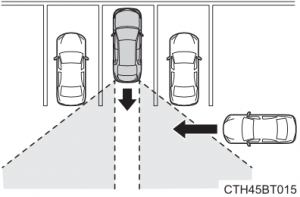 Vehicles that the sensors cannot detect due to obstructions
Vehicles that the sensors cannot detect due to obstructions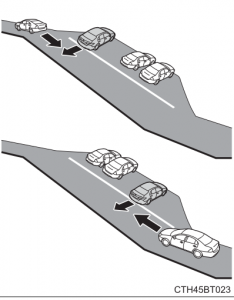 When backing up on a slope with a sharp change in grade
When backing up on a slope with a sharp change in grade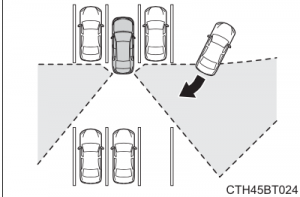 When a vehicle turns into the detection area
When a vehicle turns into the detection area